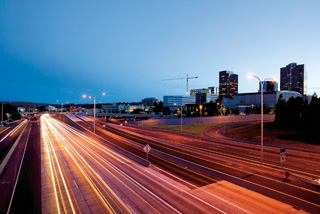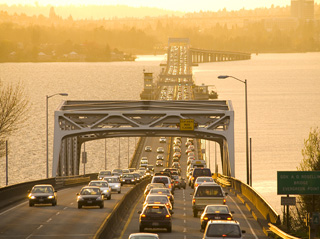|
Subscribe / Renew |
|
|
Contact Us |
|
| ► Subscribe to our Free Weekly Newsletter | |
| home | Welcome, sign in or click here to subscribe. | login |
Construction
| |
 |
August 2, 2007
Megaprojects: It’s time to rise to the challenge
HDR Engineering

Peters
|
The Puget Sound region will soon see groundbreakings for an unprecedented number of major transportation projects. Not since the build-out of the interstate highway system and construction of the Lake Washington floating bridges has the region seen such a high level of construction activity.
Analysts anticipate that the population of the Puget Sound region will grow by over 1 million people by 2020. The region’s solid growth, combined with the aging and obsolescence of our existing infrastructure, has greatly increased the need for such transportation megaprojects as the new Tacoma Narrows Bridge, Sound Transit’s Link light rail, the state Route 520 floating bridge, the Alaskan Way Viaduct and Interstate 405.
In addition to addressing distinct infrastructure needs, these megaprojects will collectively benefit our region. As key elements in our regional transportation network, these projects will support economic as well as sustainable growth.
We will see reduced congestion and improved travel times, wider alternative transportation options, greater freight mobility and enhanced safety.
Megaprojects are different
The size, duration and technical complexity of these projects result in a variety of challenges unique to megaprojects.
By their very nature, large construction projects cover a wide swath, crossing many different communities. Abutters range from residences and parkland to institutions and commercial facilities. With such a diverse array of project stakeholders, achieving any type of consensus can be difficult.
Nonetheless, political and community consensus, if not unanimity, can be achieved.
Aggressive programs for community participation, outreach to affected businesses and institutions, identification and mitigation of both construction-phase and long-term impacts, and widely disseminated project information are increasingly important. While there is a price tag for each of these activities, and costly items like some mitigation measures can be tempting to cut, they can be key to the ultimate acceptance and success of a megaproject.
Large construction projects also face numerous regulatory hurdles at the federal, state and local levels. With the increasing focus on protection of endangered species, environmental justice in communities and analysis of “cumulative effects” (that is, the cumulative impacts of the proposed action in addition to previous and planned future actions), the requirements of both the federal and state environmental protection acts can be far-reaching.
Most of these regulatory requirements must be addressed well in advance of construction, sometimes taking years to accomplish. Public agencies typically bring in a team of experts to assess a project’s impacts in parallel with early design activities. Accordingly, a project’s design can change significantly as the regulatory process is addressed.
Additionally, the sheer volume of planned construction work presents its own set of challenges. Most construction contractors are currently very busy, and it is reflected in escalating bid prices and a reduction in potential project bidders. Coupled with the decreasing workforce in the construction trades, these concerns will require agencies to carefully time and structure their projects to take advantage of market forces.
Most important, megaprojects extend over many years, and we can count on inevitable changes in the political and regulatory landscapes, shifting community priorities, and both project successes and setbacks.
The key to executing ambitious construction programs will be in maintaining momentum over the long term. This requires providing strong leadership, articulating clear-cut missions, building and maintaining public consensus, providing transparency to both the public and the press, and instilling an ongoing sense of urgency among all participants.
Alternative delivery methods
| Megaprojects on tap |
|
I-405 corridor
• Adds capacity, relieves congestion and improves safety • Benefits users of carpools, vanpools and transit, as well as single-occupancy vehicles and freight users • Design-build being applied to several sections currently under construction • Over $3 billion in funding available if RTID/ST2 passes Alaskan Way Viaduct • Currently authorized for over $900 million of early safety and mobility projects • Includes a new grade-separated roadway in Sodo, upgrades to the Battery Street Tunnel, utility relocation and limited seismic retrofit of existing structures • A preferred approach for the waterfront area to be developed by the state, city of Seattle and King County • $2.4 billion in funding currently available SR 520 • Replaces the Evergreen Point Floating Bridge and Portage Bay Bridge to withstand earthquakes and windstorms • Reconstructs the roadway corridor from I-5 to just west of I-405 to include four general-purpose lanes and two HOV lanes • Estimated costs range from $3.9 billion to $4.4 billion, with construction starting in 2012 Link light rail • Sound Transit’s initial light-rail line, which connects downtown Seattle to Tukwila, then extends to Sea-Tac Airport, opens in 2009 • $2.5 billion in funding includes a new transit tunnel through Beacon Hill, retrofit of the downtown bus tunnel for light-rail service and a new maintenance and operations facility in Sodo • Additional light-rail lines proposed in RTID/ST2 |
To meet the challenges unique to megaprojects, there is an increasing emphasis on alternative delivery methods and innovative project execution. While solutions vary, there is a common set of goals: improve communication, increase the speed of project delivery and ensure a quality product.
Both the Washington State Department of Transportation and Sound Transit have used project team co-location as a tool for improving communication and coordination during planning, permitting, design and construction.
Co-location provides shared office space with agency staff and their design consultants, effectively forming a seamless organization. This unified approach has helped to improve communication and speed project delivery while still allowing the public agencies to retain full decision-making authority and accountability for the project.
Alternative delivery methods, such as design-build, also can help agencies speed up their projects while still ensuring that they obtain a highly qualified team of designers and constructors.
In addition to design-build, there may be opportunities to use public-private partnerships (tapping private-sector financing), alliancing (a teaming concept developed overseas) and DBOM (design-build-operate-maintain) contracts.
Agencies, once locked into low-bid contracting, are now finding other tools available for their programs. These alternatives give public agencies the ability to determine the optimum method for their projects.
Projects on the ballot
The funds generated by the “nickel” gas tax of 2003 and the Transportation Partnership Act of 2005 have supported WSDOT’s work to date on major projects for I-405, the Alaskan Way Viaduct and SR 520.
Additional funding for these projects, as well as for extension of Sound Transit’s light-rail system and other important megaprojects, will appear on the Regional Transportation Improvement District/Sound Transit 2 ballot measure this November. It is essential that we build a strong base of support in the Puget Sound region for these measures, which will fund a wide range of important projects.
If passed, RTID/ST2 will provide a total of $10.8 billion for the expansion of Sound Transit’s system and $7 billion for roadways. This includes funding for light-rail extensions to the Eastside, the Tacoma Dome and Lynnwood. It will also provide a new streetcar at First Hill in Seattle, new stations and parking facilities, among numerous other congestion-relief and mobility projects.
One thing is certain — these major programs will bring change to the region. While these projects will result in numerous improvements in mobility and congestion relief, they will also bring us improved models for building project consensus, project execution and stewardship of the public’s investment.
David A. Peters is a senior vice president with HDR Engineering in Bellevue.
Other Stories:
- Design-build shaved 2 years off Narrows project
- I-405 upgrades just around the bend
- Hood Canal work continues apace despite obstacles




